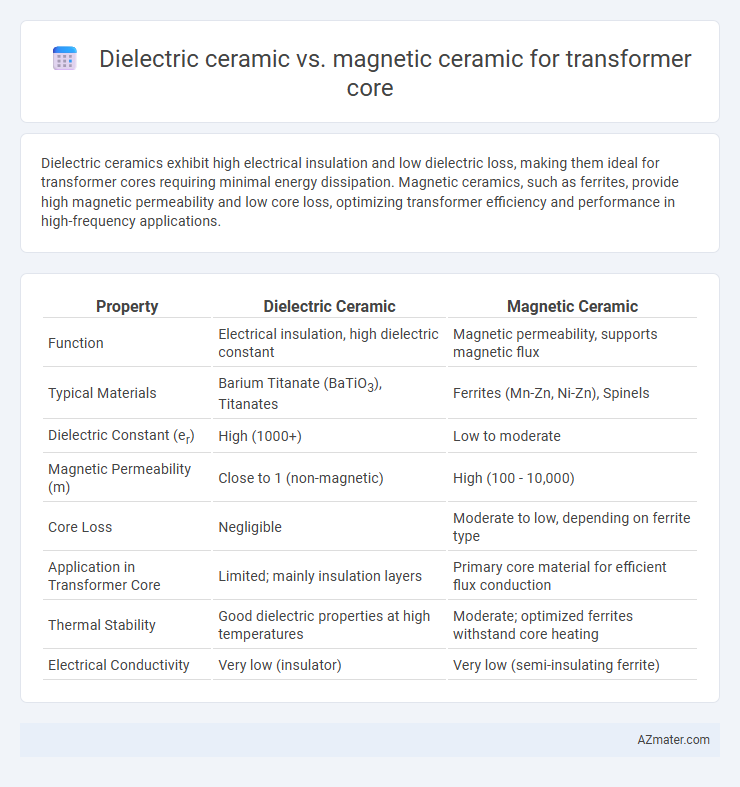Dielectric ceramics exhibit high electrical insulation and low dielectric loss, making them ideal for transformer cores requiring minimal energy dissipation. Magnetic ceramics, such as ferrites, provide high magnetic permeability and low core loss, optimizing transformer efficiency and performance in high-frequency applications.
Table of Comparison
| Property | Dielectric Ceramic | Magnetic Ceramic |
|---|---|---|
| Function | Electrical insulation, high dielectric constant | Magnetic permeability, supports magnetic flux |
| Typical Materials | Barium Titanate (BaTiO3), Titanates | Ferrites (Mn-Zn, Ni-Zn), Spinels |
| Dielectric Constant (er) | High (1000+) | Low to moderate |
| Magnetic Permeability (m) | Close to 1 (non-magnetic) | High (100 - 10,000) |
| Core Loss | Negligible | Moderate to low, depending on ferrite type |
| Application in Transformer Core | Limited; mainly insulation layers | Primary core material for efficient flux conduction |
| Thermal Stability | Good dielectric properties at high temperatures | Moderate; optimized ferrites withstand core heating |
| Electrical Conductivity | Very low (insulator) | Very low (semi-insulating ferrite) |
Introduction: Understanding Transformer Core Materials
Transformer cores rely on materials with specific magnetic properties to efficiently channel magnetic flux and minimize energy loss. Dielectric ceramics exhibit high electrical insulation and low dielectric loss, making them suitable for applications needing electrical isolation but offering limited magnetic performance. Magnetic ceramics, such as ferrites, provide high magnetic permeability and low eddy current losses, crucial for enhancing transformer core efficiency and reducing heat generation.
What Are Dielectric Ceramics?
Dielectric ceramics are insulating materials with high electrical resistance and strong dielectric properties, making them ideal for transformer cores that require minimal energy loss and efficient electric field management. Unlike magnetic ceramics, which are primarily used for their magnetic permeability to enhance magnetic flux, dielectric ceramics prevent current leakage and improve thermal stability in high-frequency transformer applications. Their ability to maintain high dielectric strength and low dielectric loss ensures enhanced performance and reliability in electronic components.
What Are Magnetic Ceramics?
Magnetic ceramics, also known as ferrites, are inorganic compounds that exhibit high magnetic permeability and low electrical conductivity, making them ideal for transformer cores to reduce eddy current losses. These materials typically consist of iron oxides combined with other metals like nickel, zinc, or manganese, forming a crystalline structure that enhances magnetic performance. Dielectric ceramics, in contrast, are insulating materials primarily used for their high electrical resistance and are unsuitable for magnetic applications in transformer cores.
Dielectric Ceramic Properties and Applications
Dielectric ceramics exhibit high electrical resistivity, low dielectric loss, and excellent insulation properties, making them ideal for transformer cores requiring minimal energy dissipation and enhanced electrical isolation. Their high dielectric constant and thermal stability support efficient energy storage and management in high-frequency transformer applications. These materials are widely utilized in capacitors and insulating layers within transformers, enabling improved performance in power distribution and electronic communication systems.
Magnetic Ceramic Properties and Applications
Magnetic ceramics, such as ferrites, exhibit high magnetic permeability, low electrical conductivity, and excellent magnetic saturation, making them ideal for transformer cores. Their ability to minimize eddy current losses and withstand high-frequency operations enhances energy efficiency and reduces heat generation in transformers. Common applications include high-frequency transformers, inductors, and electromagnetic interference suppression components in power electronics.
Core Losses: Dielectric vs Magnetic Ceramics
Magnetic ceramics, such as ferrites, are primarily used for transformer cores due to their low core losses at high frequencies, which enhances energy efficiency and reduces heat generation. Dielectric ceramics generally exhibit higher core losses in transformer applications because they lack the magnetic permeability required to effectively channel magnetic flux. Optimizing transformer core materials by using magnetic ceramics minimizes core losses, improves performance, and enables operation at higher frequencies compared to dielectric ceramic alternatives.
Efficiency and Performance Comparison
Dielectric ceramics, known for their high insulation properties, offer lower core losses and improved energy efficiency in transformer cores compared to magnetic ceramics, which typically possess higher magnetic permeability but can suffer from increased hysteresis and eddy current losses. Magnetic ceramics, such as ferrites, excel in high-frequency applications due to their reduced eddy current loss and moderate permeability, enhancing performance in compact transformer designs. Efficiency in transformer cores depends strongly on the balance between dielectric strength and magnetic saturation, with dielectric ceramics favoring electrical insulation and magnetic ceramics optimizing magnetic flux conduction for improved performance.
Cost and Manufacturing Considerations
Dielectric ceramics used in transformer cores generally offer lower raw material costs but require precise manufacturing techniques to ensure optimal electrical insulation and minimal dielectric losses. Magnetic ceramics, such as ferrites, demand more complex processing to achieve high magnetic permeability and low hysteresis losses, often resulting in higher production expenses. Manufacturing challenges for magnetic ceramics include sintering at controlled temperatures and maintaining strict compositional uniformity, directly impacting overall transformer core cost-efficiency.
Suitability for Specific Transformer Types
Dielectric ceramics are generally unsuitable for transformer cores due to their high electrical resistance and low magnetic permeability, which limit magnetic flux conduction, making them ideal for insulating components rather than core materials. Magnetic ceramics, such as ferrites, exhibit high magnetic permeability and low core losses at high frequencies, making them highly suitable for high-frequency transformers used in power supplies and signal transformers. For power transformers operating at 50/60 Hz, laminated silicon steel cores are preferred over both dielectric and magnetic ceramics because of their superior magnetic properties and minimal hysteresis losses.
Future Trends in Transformer Core Materials
Dielectric ceramics, known for their high electrical insulation and low dielectric loss, are increasingly researched for transformer cores aiming to reduce energy dissipation and improve efficiency in high-frequency applications. Magnetic ceramics, particularly soft ferrites, dominate transformer core technology due to their superior magnetic permeability and low coercivity, essential for minimizing core losses and enhancing performance at high frequencies. Future trends in transformer core materials emphasize the development of composite ceramics combining dielectric and magnetic properties to achieve optimized energy efficiency, thermal stability, and miniaturization for advanced power electronics and smart grid applications.

Infographic: Dielectric ceramic vs Magnetic ceramic for Transformer core
 azmater.com
azmater.com